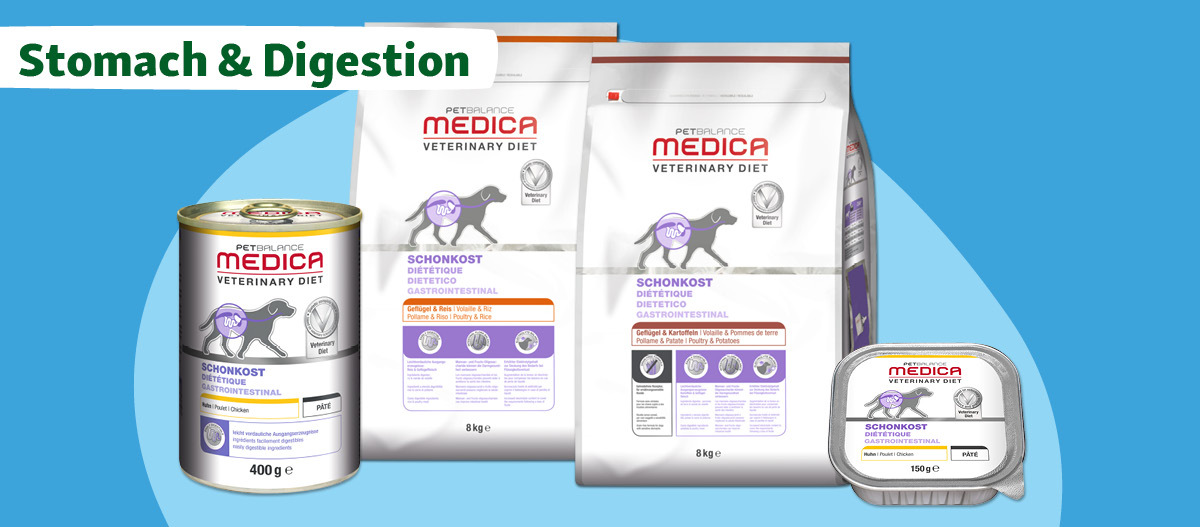In Most Cases Harmless, Sometimes an Alarm Signal: Vomiting in Dogs
07.10.2022 - Reading time: 2 minutes

Nausea and vomiting are some of the most frequent health problems in a dog which the dog’s owner has to deal with. There is a large bandwidth of possible causes. In most cases, the dog only vomits for a short time and there is no cause for alarm. However, there are also serious illnesses whose symptoms include “vomitus”. If the dog persists in vomiting, or if it is tangibly unwell, you need to visit the vet with your dog.
Vomiting in dogs: What happens
Vomiting is a protective reflex of the body and is one of the most important defence mechanisms in order to protect the dog from harm. Toxins, foreign objects and harmful food can be excreted quickly and effectively. Vomiting in dogs cannot be overlooked and is normally accompanied by clear noises.
It is divided into 3 phases:
- Nausea/feeling sick: It is expressed in dogs through increased licking of the lips, salivating, smacking its lips, yawning and swallowing. Many dogs eat grass when they feel sick. It makes it easier to trigger the vomiting.
- Retching: Dogs can retch best when they are standing and their back is arched. Diaphragm and stomach muscles contract rhythmically, resulting in loud noises. The stomach contents are pumped into the oesophagus and from there move into the mouth.
- Vomiting: The dog vomits out the contents of its stomach, whilst the retching stops. In this way it is ensured that the epiglottis can remain closed so that the vomit cannot enter the windpipe.
Causes of vomiting in dogs
There are many different reasons for a dog to vomit. It can be a symptom for an underlying illness or act as an acute protective mechanism. In many cases, the dog vomits because there is an irritation or excessive expansion of the digestive organs.
The acute causes include:
- Rapid bolting or intake of excessive amounts of food
- Swallowing a foreign object
- Intake of rotten or incompatible feed
- Food poisoning
- Inflammations in the stomach and/or intestine
- Infections with parasites, viruses or bacteria
If vomiting occurs regularly or over days and weeks independently of food intake, this could be a symptom of a serious illness.
Examples of possible illnesses are:
- Liver and kidney diseases
- Diabetes
- Pancreatitis
- Tumours
- Morbus Addison
Important: Whether it is acute or chronic – If your dog shows other signs of being unwell in addition to vomiting such as tiredness or apathy, or if it does not eat or cannot defecate for several hours, help from a vet must be sought immediately.
Types of vomiting in dogs
The vomit can have a very different appearance. It provides you with information about the possible causes of the vomiting.
- Dog vomits up yellow: When dogs vomit up yellow, foaming liquid, it is gastric acid. In most cases, this only means that the stomach is empty.
- Dog vomits up brown: The brown colour of the vomit can be attributed to parts of the feed. But also older, congealed blood is also brown to black. If the vomit contains faeces, there is an immediate risk to your dog’s life. It can be a sign of a bowel obstruction. Off to the vet!
- Dog vomits up feed: Frequently, the cause is excessive bolting of food or in an intolerability. In most cases, the dog only vomits once or twice. The feed needs to be reconsidered. Please note: Immediate vomiting after the intake of feed or water can be a sign of a twisted stomach. In these cases, contact the vet immediately as there is a risk to your dog’s life!
- Dog vomits up water: Very runny vomit is initially no cause for panic. But if your dog vomits several times and brings up a lot of fluid, there is the risk of it becoming dehydrated.
- Dog vomits up blood: Reddish vomit is a signal for alarm. Straight to the vet!
- Dog vomits up foam or mucus: Small quantities are often part of a dog’s vomit. If they are large quantities, this could be an indication of poisoning.
Important: As soon as the colour of the vomit deviates from the food eaten and the yellow of the gastric liquid, there is always cause for concern. If the vomit is red, black, brown, green or blue, you must seek out a vet immediately.
Diagnose and treatment of vomiting in dogs
If you have to visit the vet, the focus is on rapid symptomatic assistance and the searching for the causes. In most cases, the vet will supply fluid via a drip and – if necessary – stop the acute vomiting with medication.
A precise description of the circumstances of the vomiting, the accompanying symptoms and the appearance of the vomit helps to find the causes. Treatment will be given depending on the cause.

What should you do when your dog vomits?
Vomiting in dogs is one of the most frequent health problems with which dog owners are confronted. If your dog also has diarrhoea and looks tired but stable overall, this strongly indicates a gastrointestinal infection. This normally passes by itself within 24 hours.
You can take suitable measures as follows:
- ensure sufficient intake of fluids
- lots of rest
- keep the dog warm
- no feed (as long as the vomiting continues)
- after a 24-hour period of fasting – offer a Moro carrot soup (when the vomiting has stopped)
Summary: vomiting in dogs
- Vomiting occurs frequently in dogs.
- It can have different causes.
- If the vomit is noticeably coloured or has a strong smell, rapid assistance is required. If possible, fill some of the vomit in a bag or container and take it to the vet. This helps enormously in the diagnosis.
- Persistent vomiting must be clarified by the vet as quickly as possible.
- Simple gastrointestinal disorders mostly pass within 24 hours.


